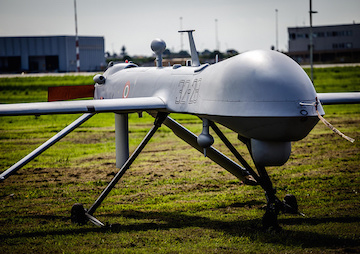America’s Secret African Drone War Against Islamic State
The Air Force has revealed that a force based in the Horn of Africa spent more than a year targeting Islamic State as part of Operation Inherent Resolve, the undeclared war on the militant group in Iraq and Syria. Allied Joint Force Command Brunssum / CC BY-SA 2.0
1
2
3
Allied Joint Force Command Brunssum / CC BY-SA 2.0
1
2
3
Despite the supposedly temporary nature of the site, U.S. Africa Command (AFRICOM) “directed an expansion of operations” at Chabelley and, in May 2014, the U.S. signed a “long-term implementing arrangement” with the Djiboutian government to establish the airfield as an “enduring” base, according to documents provided to the House Appropriations Committee earlier this year by the Undersecretary of Defense (Comptroller).
Click here to see a larger version
Chabelley Airfield, satellite photo, April 2013.
Click here to see a larger version
Chabelley Airfield, satellite photo, August 2015.
The Djiboutian Solution to the Islamic State
As 2014 was coming to a close, Lieutenant Colonel Dennis Drake took command of the 60th Expeditionary Reconnaissance Squadron at Chabelley. Under his watch, the unit reportedly carried out combat operations in support of three combatant commanders. AFCENT failed to respond to a request for clarification about which commands were involved, but Gettinger speculates that AFRICOM; U.S. Central Command (CENTCOM), responsible for the Greater Middle East; and Special Operations Command were the most likely.
 Before U.S. drones moved from Camp Lemonnier to Chabelley, according to secret Pentagon documents exposed by the Intercept in October, a Special Operations task force based there conducted a drone assassination campaign in nearby Yemen and Somalia. Gettinger believes the missions continued after the move. “We know that MQ-1s have been involved in counterterrorism operations in the Horn of Africa and Predators have for many years been flying missions over Yemen,” he told me recently by phone, noting however that the strikes in Yemen have slowed of late.
Before U.S. drones moved from Camp Lemonnier to Chabelley, according to secret Pentagon documents exposed by the Intercept in October, a Special Operations task force based there conducted a drone assassination campaign in nearby Yemen and Somalia. Gettinger believes the missions continued after the move. “We know that MQ-1s have been involved in counterterrorism operations in the Horn of Africa and Predators have for many years been flying missions over Yemen,” he told me recently by phone, noting however that the strikes in Yemen have slowed of late.
“There were no U.S. drone strikes reported in Yemen in November, the second calendar month this year without a reported attack,” researchers with the Bureau of Investigative Journalism noted earlier this month. After a lull since July, a November drone strike in Somalia killed at least five people, according to local reports. And just last week, the Pentagon announced that another U.S. strike in Somalia had killed Abdirahman Sandhere, a senior leader of the militant group al-Shabaab.
Drake’s 60th Expeditionary Reconnaissance Squadron, however, focused its firepower on another target: the Islamic State. The unit was “a large contributor to OIR,” according to Major Tim Smith of AFCENT Public Affairs, and “executed combat flight operations for AFCENT in support of Operation Inherent Resolve.”
Based in Africa, it was, according to Lieutenant Colonel Kristi Beckman, director of public affairs at the Combined Air Operations Center at al-Udeid air base in Qatar, “a geographically separated unit.” By the beginning of October 2015, drones flown out of Chabelley had already logged more than 24,000 hours of intelligence, surveillance, and reconnaissance (ISR), according to the chief of operations analysis and reconstructions of the 380th Expeditionary Operations Group, its parent unit. (In an Air Force news release, that officer was identified only as “Major Kori,” evidently to obscure his identity.) According to Kori, Chabelley’s drones were also “responsible for the neutralization of 69 enemy fighters, including five high-valued individuals.”
AFCENT failed to provide additional details about the missions, those targeted, or that euphemism, “neutralization,” which was once a favored term of the CIA’s often muddled and sometimes murderous Phoenix Program that targeted the civilian “infrastructure” of America’s enemies during the Vietnam War. Beckman did, however, confirm that “neutralizations” took place in Iraq and/or Syria.
Click here to see a larger version
A satellite photo of Predator and Reaper drones at Chabelley Airfield during Lieutenant Colonel Dennis Drake’s time in command of the 60th Expeditionary Reconnaissance Squadron.
Despite the loss of a unit that had flown tens of thousands of hours of ISR missions and attacked scores of targets, Smith says that America’s war on the Islamic State has not suffered. “Coalition efforts in the region are not hampered,” he assured me. “Operation Inherent Resolve has the personnel and assets necessary to continue aerial dominance within the region,” according to Smith. “Though the squadron isn’t needed anymore, there is sufficient capability within the AOR [area of operations] to ensure the needs of the mission are met.”
The Beginning of the End or the End of the Beginning for Drones in Djibouti?
Some commentators have speculated that the transfer of the 60th Expeditionary Reconnaissance Squadron’s Predators indicates a possible end to U.S. drone missions from Djibouti. Others suggest that the move offers a clear indication of demands for the robot aircraft elsewhere in the world.
Your support matters…Independent journalism is under threat and overshadowed by heavily funded mainstream media.
You can help level the playing field. Become a member.
Your tax-deductible contribution keeps us digging beneath the headlines to give you thought-provoking, investigative reporting and analysis that unearths what's really happening- without compromise.
Give today to support our courageous, independent journalists.






You need to be a supporter to comment.
There are currently no responses to this article.
Be the first to respond.